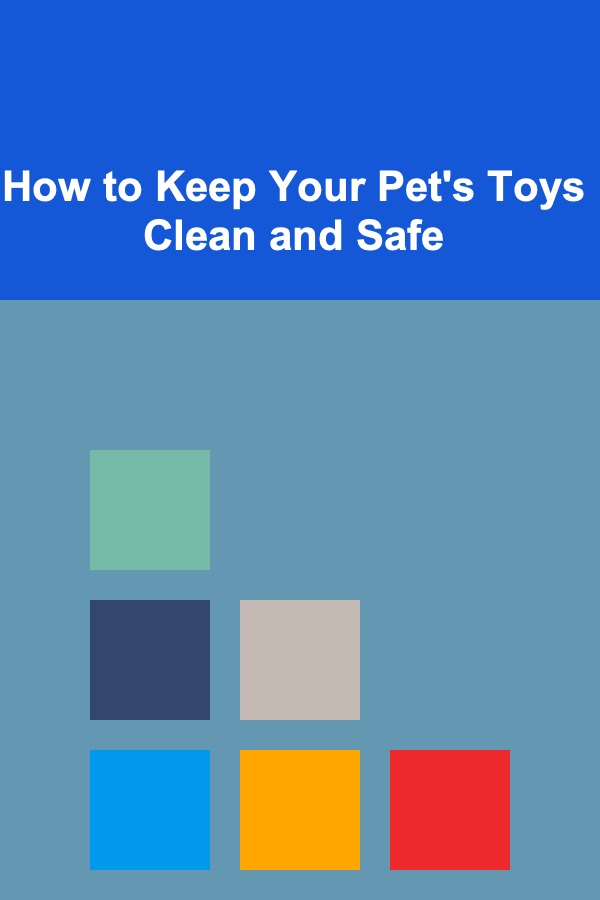
How to Keep Your Pet's Toys Clean and Safe
ebook include PDF & Audio bundle (Micro Guide)
$12.99$7.99
Limited Time Offer! Order within the next:

Pets bring joy and companionship to our lives, and we, in turn, take every effort to make sure they are happy and healthy. One way we do this is by providing them with toys to play with. Pet toys are not only fun for pets, but they also help with their mental stimulation, physical exercise, and bonding with their owners. However, while pet toys are essential, keeping them clean and safe is equally important.
In this comprehensive article, we will explore the importance of keeping your pet's toys clean and safe, methods for doing so, common cleaning mistakes to avoid, and tips for choosing safe and durable pet toys. Whether you have a dog, cat, or even a smaller animal like a rabbit or guinea pig, keeping their toys in good condition ensures their health, well-being, and continued enjoyment.
Why Cleaning Your Pet's Toys is Important
1. Health Concerns and Hygiene
Pet toys are constantly in contact with saliva, dirt, food, and other substances that can harbor bacteria, viruses, and germs. Over time, these germs can multiply and cause health problems for your pet. If toys aren't regularly cleaned, the bacteria can lead to infections in your pet's mouth, ears, or digestive system, especially when they chew or lick toys.
Pets, especially dogs and cats, tend to chew and bite toys, so bacteria and pathogens are directly introduced into their bodies. Keeping the toys clean helps reduce the risk of these infections, making it crucial to maintain proper hygiene.
2. Preventing Allergies and Irritations
Old toys, particularly ones that have been exposed to mold or mildew, can lead to allergic reactions in pets. Dust, dirt, and allergens can accumulate on the toys, leading to skin irritations, respiratory issues, and other allergic symptoms. Regular cleaning helps minimize exposure to allergens, ensuring your pet remains comfortable and healthy.
3. Avoiding Toxicity
Many pet toys are made from plastics or rubber materials, which can break down over time, releasing small particles or toxic substances into the environment. Older, worn-out toys could pose a risk of toxicity if they are chewed on or ingested by your pet. Cleaning toys properly helps you monitor their condition, preventing potential exposure to harmful materials.
4. Prolonging the Life of Pet Toys
Keeping your pet's toys clean not only protects their health but also helps maintain the longevity of the toys. Toys that are well-maintained will last longer, providing more value for money. If a toy becomes too dirty or worn, it may lose its structural integrity, making it less enjoyable and even unsafe for your pet to use.
Methods for Cleaning Pet Toys
The specific cleaning methods for pet toys depend on the material and design of the toy. In this section, we will look at different types of pet toys and the best ways to clean them.
1. Rubber and Plastic Toys
Rubber and plastic toys are among the most common types of pet toys. These toys can be easily cleaned with a few simple steps.
Cleaning Procedure:
- Step 1: Use warm, soapy water to scrub the toy. You can use mild dish soap and a soft sponge or cloth to clean the surface. For tougher stains, a toothbrush can be used to scrub away dirt from grooves or textured areas.
- Step 2: After scrubbing, rinse the toy thoroughly to remove any soap residue.
- Step 3: Allow the toy to air dry completely before giving it back to your pet. Avoid using a towel to dry it, as this can introduce additional bacteria.
- Step 4: For deeper cleaning, especially for toys with hard-to-reach areas, you can disinfect the toy by soaking it in a solution of equal parts water and white vinegar. Let it soak for 10--15 minutes before rinsing and drying.
Note: Some rubber toys can be put in the dishwasher for a deep clean, but check the manufacturer's instructions to ensure that they are dishwasher-safe.
2. Plush and Fabric Toys
Plush toys are softer and more delicate, and they often contain stuffing, making them more challenging to clean. However, regular washing is necessary to remove dirt, bacteria, and odors.
Cleaning Procedure:
- Step 1: If the plush toy is machine washable, place it in a laundry bag or pillowcase to protect it during washing. Use mild detergent and cold water to prevent damage to the fabric and stuffing.
- Step 2: For toys that aren't machine washable, spot clean them using a cloth soaked in soapy water. Gently scrub away stains, focusing on dirty areas without soaking the entire toy.
- Step 3: After washing, allow the plush toy to air dry completely before returning it to your pet. Avoid putting it in the dryer as the heat can damage the fabric and cause it to lose its shape.
- Step 4: Regularly inspect the toy for loose threads or missing buttons, as these can be choking hazards.
Note: For tough odors, you can sprinkle some baking soda on the toy before washing. Allow it to sit for a few hours and then vacuum it off before cleaning.
3. Tennis Balls
Tennis balls are a favorite toy for many dogs, but they can accumulate dirt and saliva quickly. Cleaning tennis balls requires special attention due to their felt covering.
Cleaning Procedure:
- Step 1: Toss the tennis balls in the washing machine with a load of laundry. Use cold water and mild detergent, and avoid using fabric softener, as it can damage the felt.
- Step 2: If the tennis balls are particularly dirty, pre-soak them in a bucket of soapy water for 30 minutes to loosen any dirt or grime.
- Step 3: Dry the tennis balls by letting them air dry completely. You can also dry them in the dryer on a low heat setting.
Note: Regularly inspect tennis balls for signs of wear. Over time, the rubber can degrade, and the felt may wear away, which could lead to your dog ingesting small pieces of material.
4. Interactive and Electronic Toys
Interactive or electronic pet toys (such as ones with batteries, sound mechanisms, or moving parts) require careful cleaning to avoid damaging the internal components.
Cleaning Procedure:
- Step 1: Remove the batteries or turn off the electronic components before cleaning the toy.
- Step 2: Wipe the toy's surface with a damp cloth and mild soap. Avoid soaking the toy in water.
- Step 3: For small crevices or electronic parts, use a soft brush (like a toothbrush) to gently scrub away dirt.
- Step 4: Dry the toy thoroughly, paying special attention to the areas where electronic components are housed. Allow the toy to air dry completely before turning it back on or reinserting batteries.
Note: Always refer to the manufacturer's instructions for cleaning, as some interactive toys may have specific cleaning guidelines.
5. Rubber Chew Toys
Chew toys made of durable rubber material are often designed for aggressive chewers. They are excellent for keeping dogs entertained, but they still need to be cleaned to avoid bacterial buildup.
Cleaning Procedure:
- Step 1: Rinse the chew toy under warm water.
- Step 2: Use a small amount of mild soap and scrub the toy with a soft sponge or cloth.
- Step 3: If needed, soak the toy in a solution of water and white vinegar to disinfect it.
- Step 4: Rinse the toy thoroughly and let it dry completely.
Note: For a deeper clean, rubber chew toys can be boiled for a few minutes to kill bacteria and germs. Always ensure the toy is completely dry before giving it back to your pet.
Common Cleaning Mistakes to Avoid
While cleaning your pet's toys is essential, there are a few mistakes pet owners often make that can result in damage to the toys or harm to their pets.
1. Using Harsh Chemicals
Avoid using harsh cleaning chemicals or disinfectants that are not designed for pet use. These can leave harmful residues on the toys that may be ingested by your pet, leading to poisoning or chemical burns.
2. Over-Washing Plush Toys
While it's important to keep plush toys clean, washing them too frequently or in hot water can cause the fabric to lose its softness, shape, or color. Always follow the manufacturer's care instructions.
3. Using the Wrong Cleaning Tools
Some toys have intricate shapes or delicate parts. Using hard brushes, abrasive materials, or excessive scrubbing can damage the toy. Always use soft sponges or cloths and take care not to force cleaning in areas where it might cause damage.
4. Not Checking for Damage
During cleaning, it's important to check your pet's toys for signs of wear and tear. If a toy is torn, cracked, or worn out, it should be replaced to prevent your pet from swallowing parts that may pose a choking hazard.
How to Choose Safe and Durable Pet Toys
Selecting the right toys for your pet is crucial for both fun and safety. Here are some tips to help you choose safe, durable toys for your furry friends:
- Check for Materials: Look for non-toxic, pet-safe materials like natural rubber, organic cotton, or BPA-free plastics. Avoid toys made from low-quality plastics that may break down and release harmful chemicals.
- Consider Your Pet's Size and Chewing Habits: Choose toys that are appropriate for your pet's size and chewing habits. For example, if you have a dog that chews aggressively, opt for tougher, more durable toys.
- Avoid Small Parts: Ensure that the toy does not have small parts that could be a choking hazard, especially for puppies or young pets.
- Read Reviews: Look for reviews and recommendations from other pet owners to determine the durability and safety of the toy.
- Look for Certifications: Some pet toy manufacturers will have certifications for safety, such as being free from BPA or phthalates.
Conclusion
Keeping your pet's toys clean and safe is an important part of responsible pet ownership. Regular cleaning not only helps maintain your pet's health but also extends the life of the toys and ensures your pet continues to enjoy them for years to come. By following the proper cleaning methods and choosing safe, high-quality toys, you can create a fun, healthy, and safe environment for your pet to play and thrive.
Reading More From Our Other Websites
- [Organization Tip 101] How to Create a Home Inventory for Insurance Purposes
- [Home Holiday Decoration 101] How to Create Charming Holiday Porch Signs for Your Home
- [Organization Tip 101] How to Create Themed Craft Kits for Different Holidays
- [Home Pet Care 101] How to Create Wholesome & Balanced Homemade Dog Food Recipes for Sensitive Stomachs
- [Personal Care Tips 101] How to Use Eye Cream to Treat Skin Discoloration Around the Eyes
- [Personal Finance Management 101] How to Use Financial Apps to Manage Your Money More Effectively
- [Home Maintenance 101] How to Correctly Place Fire Extinguishers for Home Safety
- [Toy Making Tip 101] DIY Dream Toys: Step-by-Step Projects for Creative Builders
- [Personal Investment 101] How to Build and Sell Deep Learning-Based Software Products
- [Organization Tip 101] How to Reflect on Past Camps to Improve Future Planning

How To Keep a Birding Journal
Read More
How to Make a Checklist for Handling International Freight Forwarding
Read More
How to Pack for a Backpacking Adventure: A Minimalist Packing Checklist
Read More
How to Save Money on Groceries with a Strategic Plan
Read More
How To Select and Style Wall Art Groupings
Read More
How to Connect with Nature Through Outdoor Yoga
Read MoreOther Products

How To Keep a Birding Journal
Read More
How to Make a Checklist for Handling International Freight Forwarding
Read More
How to Pack for a Backpacking Adventure: A Minimalist Packing Checklist
Read More
How to Save Money on Groceries with a Strategic Plan
Read More
How To Select and Style Wall Art Groupings
Read More